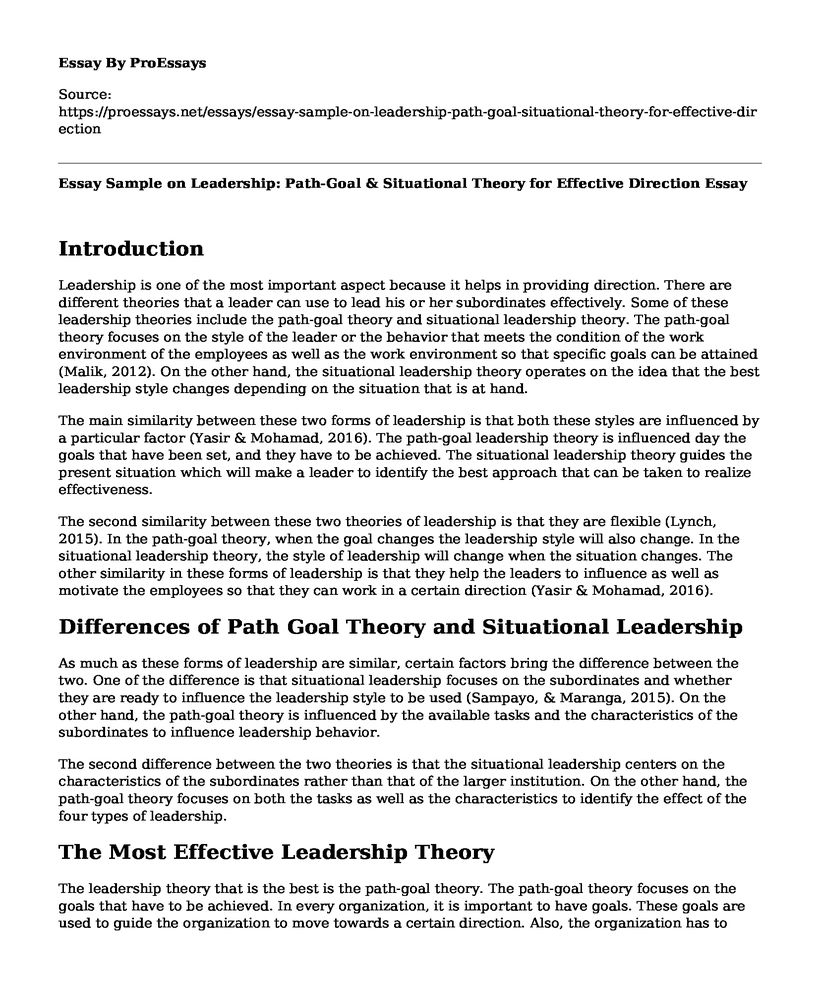Introduction
Leadership is one of the most important aspect because it helps in providing direction. There are different theories that a leader can use to lead his or her subordinates effectively. Some of these leadership theories include the path-goal theory and situational leadership theory. The path-goal theory focuses on the style of the leader or the behavior that meets the condition of the work environment of the employees as well as the work environment so that specific goals can be attained (Malik, 2012). On the other hand, the situational leadership theory operates on the idea that the best leadership style changes depending on the situation that is at hand.
The main similarity between these two forms of leadership is that both these styles are influenced by a particular factor (Yasir & Mohamad, 2016). The path-goal leadership theory is influenced day the goals that have been set, and they have to be achieved. The situational leadership theory guides the present situation which will make a leader to identify the best approach that can be taken to realize effectiveness.
The second similarity between these two theories of leadership is that they are flexible (Lynch, 2015). In the path-goal theory, when the goal changes the leadership style will also change. In the situational leadership theory, the style of leadership will change when the situation changes. The other similarity in these forms of leadership is that they help the leaders to influence as well as motivate the employees so that they can work in a certain direction (Yasir & Mohamad, 2016).
Differences of Path Goal Theory and Situational Leadership
As much as these forms of leadership are similar, certain factors bring the difference between the two. One of the difference is that situational leadership focuses on the subordinates and whether they are ready to influence the leadership style to be used (Sampayo, & Maranga, 2015). On the other hand, the path-goal theory is influenced by the available tasks and the characteristics of the subordinates to influence leadership behavior.
The second difference between the two theories is that the situational leadership centers on the characteristics of the subordinates rather than that of the larger institution. On the other hand, the path-goal theory focuses on both the tasks as well as the characteristics to identify the effect of the four types of leadership.
The Most Effective Leadership Theory
The leadership theory that is the best is the path-goal theory. The path-goal theory focuses on the goals that have to be achieved. In every organization, it is important to have goals. These goals are used to guide the organization to move towards a certain direction. Also, the organization has to ensure tomtit develop the strategies that will be used to attain these goals.
One of the strategies is to ensure that there is sound leadership in place. This issue will be guided by the path-goal theory which will define the best leadership that should be used. The second reason why the path-goal theory is the best leadership theory is to involve the subordinates. The subordinates are the most important part of an organization since they undertake various activities that ensure there is an improvement. This leadership theory will involve the employees so that the best attain the goals can be determined.
The other reason for selecting the path-goal theory is that it helps to choose a leadership style that fits the environment as well as the employees. This aspect will make this the leadership style that will be selected to be accepted by the employees.
References
Lynch, B. (2015). Partnering for performance in situational leadership: a person-centeredleadership approach. International Practice Development Journal, 5. Retrieved from:https://www.fons.org/Resources/Documents/Journal/Vol5Suppl/IPDJ_05 (suppl) _05.pdf
Malik, S. H. (2012). The relationship between a leader's behaviors and subordinate jobexpectancies: A path-goal approach. Pakistan Journal of Commerce and Social Sciences(PJCSS), 6(2), 357-371. Retrieved from: https://www.econstor.eu/handle/10419/188064
Yasir, M., & Mohamad, N. A. (2016). Ethics and morality: Comparing ethical leadership withservant, authentic and transformational leadership styles. International Review ofManagement and Marketing, 6(4S), 310-316. Retrieved from:http://econjournals.com/index.php/irmm/article/view/2504
Cite this page
Essay Sample on Leadership: Path-Goal & Situational Theory for Effective Direction. (2023, Jan 11). Retrieved from https://proessays.net/essays/essay-sample-on-leadership-path-goal-situational-theory-for-effective-direction
If you are the original author of this essay and no longer wish to have it published on the ProEssays website, please click below to request its removal:
- Project Portfolio Office, Project Management Office and Program Management Office
- Essay Sample on Risk Management
- Leadership and Organizational Development Principles and Applications Paper Example
- Essay Sample on Humility in Nursing Leadership
- Managing and Leading Teams Essay
- Essay on Managing Change Successfully: Implementing an Interprofessional Collaboration Project
- Essay Example on Elderly Fire Risk Reduction: Identifying & Prioritizing Risks







